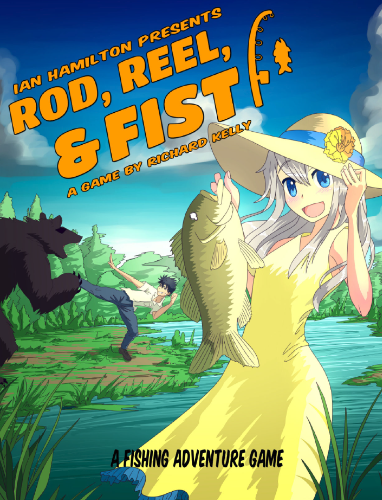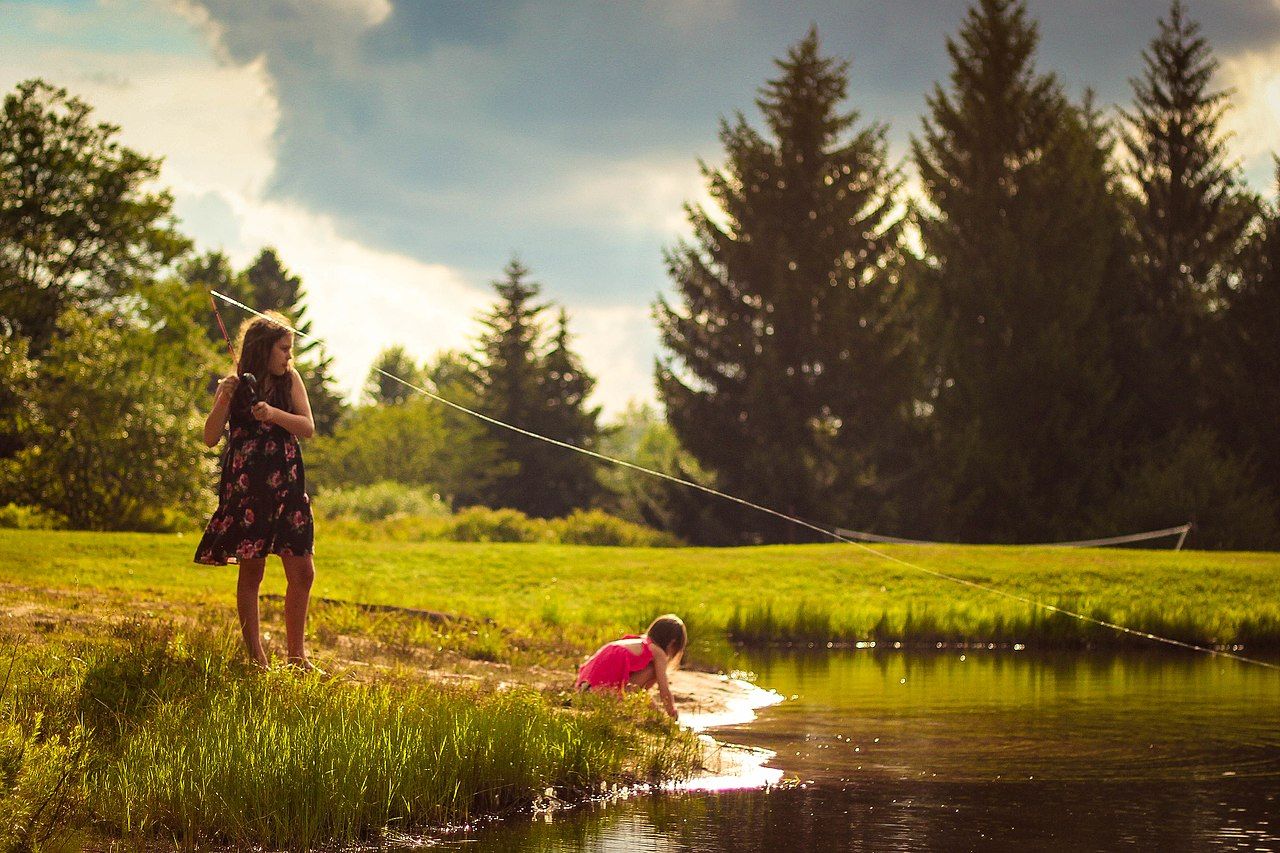Rod, Reel, & Fist (Review)
Rod, Reel, & Fist is a system-forward fishing simulation RPG by Richard Kelly that uses the heightened aesthetics of anime to reign in its absurd premise.
 Rod, Reel, & Fist cover art by Joe Bush.
Rod, Reel, & Fist cover art by Joe Bush.
It’s 288 pages, available as a PDF from itch.io for $131 and as a softcover POD book from DriveThru RPG for $35. It was also the product of a Kickstarter campaign. I have the PDF from the TTRPGs for Trans Rights in Florida bundle a few months ago.
As an aside, Richard Kelly loves a fishing minigame. The itch store page gleefully links to any other game about fishing, and he himself has released a fishing supplement for Mörk Borg, Fisk Borg. I understand the system is similar, but I haven’t read it.
 What did you get?, Masayuki, CC-By 2.0 via Wikimedia Commons.
What did you get?, Masayuki, CC-By 2.0 via Wikimedia Commons.
Really?
The game looks fun! The setting is engaging, the rules are intriguing, and the details are imaginative. Picking up the book and reading from the beginning, I was unsure what it might play like. We start with collaborative world-building. Is it a story game? Then comes the crunch. Is there going to be tactical fish combat? But character creation is very simple, maybe this is going to be a hexcrawling OSR-type affair.2 These fish are kind of … goofy. Is this a comedy? As lenses continue to suggest themselves, the bigger picture becomes clearer and clearer. I imagine all kinds of games, but I also start to feel how they would be similar, think what adjustments would need to be made to differentiate them. “We are knights of Camelot on a great quest … to catch the poisson d’or.” “Our frontier town is being terrorized by bandits … so we’re seeking the Squid, Sheriff.” This slow unfolding and refinement of the central idea makes the book a joy to read.
In its simplest form, players, guided by a “swamp being” (the GM), take on the roles of fishers from a village, searching “The Old Region” for the “Fish of Legend,” which has magical abilities to avert or repair the tragedy looming over their home. The default setting is rural Japan in the 1980s, but details beyond that vary.
Many items take on non-obvious mechanistic uses. This can feel a little abstract, like a video game. For example, why do skipping stones inflict stress on fish? How does a fishing rod help in animal (non-fish) combat? Best to just lean into it.
There are some delightfully weird fish and beasts. Fantastical entries like Piranha, Vegetarian and Carp, Goldenscale blend right in with Cod, Atlantic and Eel, Electric. The Scorpion, Brush reminds me of Derek Pell’s visual puns, but a similar mix of creative and practical animals make a versatile bestiary as well. We get to see some “example” fish of legend which really drive home how weird your own fish can get: “Pisces,” “The Eel of Near-Universal Levitation,” “The Cyberfish.”
The book walks a careful line between its own nominal default setting, and whatever actual setting you end up creating as a group, or using whole. You can even take your D&D group for a “beach episode,” but you’ll need to account for the existence of Athletic Shoes and Soda. I think it allows for this range well, within constraints, by always having a weirder option. Nobody is going to ask about the sodas when there’s a talking shark with a firefighter hat. And there are also always lower-fantasy options that still maintain a sense of magic without raising new questions. Vincent of the Gar Sea is a weirdo from a dimension where the only fish is gar (and he talks in puns), and I think he’s a good example of this ability to downshift by creating distance between the weirdness and the characters.
The game includes five alternate settings, which are illustrative:
- Fish of the North Star—a post-apocalyptic martial-arts western.
- I.C.E. F.I.S.H.I.N.G.—cyberpunk noir freelancers in a future where fishing is illegal.
- Jovian Sleighride—planetary romance leviathan whaling.3
- Skyhook—looting the ruins of lower-down sky islands.
- 40,000 Leagues Under the Sea—pulp adventures in an experimental submersible under an impossibly deep sea.
And six pre-made scenarios:
- The Truth of the Grotto—a generic hexcrawl sandbox.
- The Road of Fish—a generic time-bound pointcrawl with a destination.
- The Catch of the Day—a time-looped fishing mystery.
- The Ruby in the Mire—a pulp bushwhack through a beast’s domain to find a medicinal fish.
- Seasonal Migration of the Transpacific Slaughter Eels—a tower-defense siege minigame with boardgame elements.
- We Demand an Aquarium—a fishing tournament with aliens.
Finally it has some intergenerational hexcrawl rules called “Legacy Mode.” It describes these as more like a “boardgame” or a “roguelite,” which isn’t how I would have first described it, but it looks appealing regardless.
 Children fishing in pond, Luke Brugger, CC0, via Wikimedia Commons.
Children fishing in pond, Luke Brugger, CC0, via Wikimedia Commons.
288 Pages?!
There’s no reason for it to be 288 pages. The core of the game (rules, character creation, combat, gameplay, etc.) is only 48 pages. Fish, beasts, NPCs, and settings are 96 pages; sample characters, 12; scenarios, 92; advice and alternate rules, 10; the table of contents, 20.4
Some of this excess is down to crowdfunding success. Stretch goals generate engagement and hype for a project, and the author enjoys the challenge of writing and incorporating custom content. This is where many of the stranger items and creatures come from, as well as the scenarios and settings.
But a lot of this length is bloat. The basic rules don’t need to be 48 pages. They need an editor who can think about them as a game. The book is full of asides and hypotheticals and cross-references that just don’t need to be there.
Consider the core mechanic, “combining dice:” roll a pool of d6s and keep the highest, but, if you have multiples you can instead take (number on dice) + (number of dice in the matched set). Then compare the result to a target number. For example:
- ⚂⚃⚄ → 3, 4, 5 → 5
- ⚃⚃⚄ → 4+2, 5 → 6
- ⚁⚁⚁ → 2+3 → 5
This takes most of a page to explain. Which is fair, because it’s important! But then it continues:
Now, there are some limits to Combining Dice. You can’t Combine a single die with itself, so a single 2 isn’t a 2 + 1. It’s just a 2. Similarly, you can’t build pyramids out of your numbers. If you roll two 2s and one 4, those 2s Combine to become a 4, but they don’t Combine again with the other 4 you’d rolled to become a 6. (Rod, Reel, & Fist p. 32)
There’s no reason in any of the examples to suppose either of these ideas is true, yet here we have a whole paragraph explaining mechanics that aren’t in the game.5
The text is littered with examples of this low-trust cruft:
All pieces of Equipment may be traded freely between characters, but whenever a piece of Passive Equipment is traded from Fisher to Fisher, it stops providing its passive bonus until its new owner has Made Camp and gotten used to using it.
This occurs even if a clever Fisher hands their Equipment to an NPC, and then the NPC hands it to the Fisher’s intended trading partner, and this rule stops groups of Fishers from hot-potatoing a pair of Athletic Shoes back and forth. (Rod, Reel, & Fist p. 44)
You cannot produce fewer than 0 Snacks with this Type ability. (Rod, Reel, & Fist p. 37)
Even where there is no possible ambiguity to be resolved, the text can be clumsy and verbose. The “split” Fisher type can choose two other types and switch between them. But not all types are available to a split: some don’t make sense or would be too strong. Rather than give the split a blacklist (or whitelist), each excluded type contains the same statement in its own section:
If you are a Split, [this] may not be one of your selected types. (Rod, Reel, & Fist p. 38)
Which is irrelevant to anyone who is that type, and unhelpfully placed to someone building a split-type Fisher.
Similarly, Rod, Reel, and Fist recommends Pathfinder 2e-style doubling rules, but only in the middle of an item description.6
When you convert a fish into Snacks, spend a Lemon from your inventory to double the Snacks that fish gives you. This doubling is applied before any other bonuses that affect the amount of Snacks a fish gives. When in doubt, if there are multiple Snack-doubling items that seem like they should apply at the same time, multiply the Snacks the fish gives by 1 + the number of doubling items instead of applying each doubling item in sequence. (Rod, Reel, and Fist p. 46)
Why not put this with the other rules for more general reference?
Often, when I read a single-author work like this, I think it needs an editor for many small reasons: a stray reference doesn’t lead anywhere, or an idea was brought up but never developed. By contrast, Rod, Reel, & Fist is extremely consistent. The author (or editorial team) clearly has the experience and skill to manage a complex rule system, but not to present it in the best way. And it doesn’t feel like they trust the reader to play “correctly” or make intervening assumptions or use common sense. It feels besieged, like someone rewriting the rules of basketball to disallow dogs.
More generally, the information design is rough. The character sheet doesn’t have any space to write out type abilities or temperament effects. Fish can’t be cross-referenced by environment. Fishing spot mechanics are painfully verbose. Rules and advice and examples are mixed freely throughout the book, which, getting quite long, makes it easy to get lost.
 Weekend, Ludwig Boedecker, Public Domain via Wikimedia Commons.
Weekend, Ludwig Boedecker, Public Domain via Wikimedia Commons.
So … ?
Once again, I have tricked myself into reviewing a game that looks really exciting, except for one thing that’s bothering me. Here, combined with the overwhelming vision of the game’s premise, that tension fascinates me, and I haven’t been able to stop thinking about it. If you’re curious, maybe pick it up, and see if it captures your attention in the same way it’s captured mine. [Insert fishing pun]!
At time of writing there are 139 free “Community Copies” on itch.io, and the author indicates that any of their games are available for free by request as well.↩︎
In sections where the rules run so low-to-the-ground, it’s easy to forget that the game is explicitly low-lethality.↩︎
A reworking of an existing game, I think this one, but I am not sure.↩︎
The table of contents shows every heading level, which the author is aware is excessive. The PDF bookmarks only show the highest heading levels, and so are more useful for navigation.↩︎
Worse, if a player or playgroup thinks that you can combine dice in a pyramidal fashion, let them! It hardly makes a difference, mathematically, as the comparison to a target number ultimately “smooths” out the advantage for all but the largest pools against the largest target numbers.↩︎
Granted, there don’t appear to be any other doubling effects to combine it with, so this is maybe a moot point.↩︎